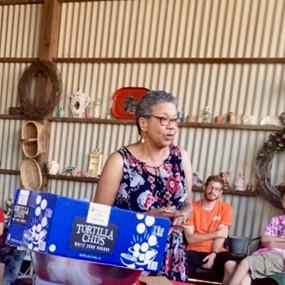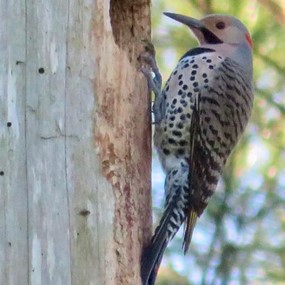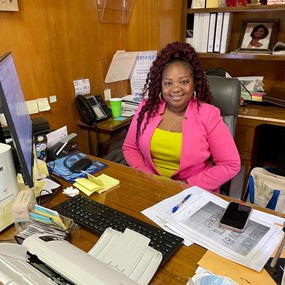Gee’s Bend Quilts Reflect Amazing Spirit, History
All my life I’ve heard of the Gee’s Bend quilts. Growing up in Alabama, it’s hard to miss hearing about the famous artistic and cultural trademarks in the state – FAME studios in Muscle Shoals, Harper Lee’s “To Kill a Mockingbird”, Lynard Skynard’s “Sweet Home Alabama”, storyteller Kathryn Tucker Windham, Fannie Flagg’s “Fried Green Tomatoes”, and the list goes on.
The Gee’s Bend quilters come to mind when thinking of this varied cultural crowd. And for good reason - their quilts are nothing short of works of art.
And like any good artists, the quilters tell unique stories with their craft. I didn’t know how unique and amazing the stories wrapped up in those quilts are until this week when I had the opportunity to visit Gee’s Bend.
The small community of Boykin, traditionally called Gee’s Bend, sits on island-like land on the Alabama River. The Bend is across the river from Camden in Wilcox County. If that sounds familiar, it might be because Wilcox County is often talked about as Alabama’s most impoverished county. But like many Alabama communities, despite the harsh economic circumstances, Wilcox County is rich in history, culture, and natural beauty.
The Bend
From its founding by Joseph Gee in the early 1800’s, Gee’s Bend, like the rest of Wilcox County, was home to many of Alabama’s small farmers and several antebellum plantations. After the Civil War, the land was home to many small family farms.
Then, in the 1930’s, Wilcox County fell into dire straits along with the rest of the country as the Great Depression struck. Small farmers in the area were hit hard, especially if they were non-landowning tenant farmers, like Gee’s Bend families. The community at Gee’s Bend was facing collapse when in 1937 the main landowner sold to the federal government.
The Farm Security Administration, one of President Roosevelt’s many community relief agencies, started a revolutionary farming cooperative called the Gee’s Bend Farm, Inc. This subdivided much of the river-island land and sold it to families. This was the first time these families, almost all of whom were African-Americans, owned and completely controlled the land that they lived and worked on. Even as the economy got worse and many people left Wilcox County and Gee’s Bend looking for opportunity, several of these land-owning African American families stayed.
Throughout this time, the women of Gee’s Bend gathered often to help neighbors and sustain their small, struggling community. One of the main ways they did this was by creating quilts out of whatever material they could find.
It’s hard to keep a good thing down. Buyers from around Alabama and the South became interested in the distinctive Gee’s Bend quilts when they hit the market in the 1960s.
In more recent years, the Gee’s Bend quilts have gained an international reputation and are heralded by experts as amazing pieces of folk art. The quilts have been displayed in art museums in Houston, Atlanta, New York, London, and elsewhere.
They have been featured in magazines, on public television and major broadcast networks, and on a 2006 U.S. postage stamp series. The popularity of the quilts has grown exponentially since, as has the price. Several of the famous quilts have sold for more than $20,000.
The Quilts
But what makes these quilts so unique? The secret lies in the resourceful minds and traditional hearts of the quilters.
Gee’s Bend has always existed as a small community of connected families. Culture and heritage have been easily shared and maintained through generations because of this, especially through traditions like quilting. Even today, the area is home to only 300 people, and they live and work there with the fresh remembrance of ancestors and neighbors.
The Gee’s Bend community has also been isolated for most of its history. The land on the Alabama River has only one road that connects it to the mainland and Camden, the nearest town across the river. By car, it takes over an hour to get to Camden by this road, and who knows how long a horse or cart ride in the 1800’s took!
In the mid 1900’s, this isolation was somewhat breached when a ferry from Gee’s Bend to Camden was set up. Unfortunately, the ferry was shut down in 1962 amidst Civil Rights action in Alabama and wasn’t opened again until 2006. The secluded community suffered from this social, political, and economic exclusion for many years, but the isolation helped maintain parts of generational culture and heritage that make their crafts and stories so exceptional.
The Trip
My trip to Gee’s Bend did not include a ferry ride. The group I was traveling with, Linden Living Democracy student Cristiana Shipma and her community partners Kathryn and Joe Friday, missed the ferry by 15 minutes. Our only other option was the hour-long drive onto the island. The ferry ride is obviously alluring because of its novelty and convenience, but the drive gave us a chance to see a great deal of Wilcox County and hear many of Mrs. Friday’s stories about the area’s history.
My first sight of one of the quilts came when we stopped at the beautiful Visitor’s and Community Center right past the town limits. The inviting wood building was recently constructed by Auburn University’s Urban Studio and is used as a community gathering place and work site for quilters.
Inside, we met two women who were eating lunch and watching “Bonanza” on television as they worked on several quilts. It was so interesting to see their art-pieces in all stages of construction around the room – piles of cloth squares on one table, some quilts half sewn on another, one being pieced together by skilled hands before us, and several completed quilts hanging on the wall (with $10,000 price tags on them!).
One of the women, Doris, told me about the building and what she was working on. And, in a “War Eagle moment”, about her grandson who just graduated from Auburn this May with a degree in biomedical science.
The ladies sent us down the road to the Quilting Collective building where another woman, Nancy, opened the workshop and store for us. It was amazing to look through all of the quilts, knowing now what extraordinary heritage is kept alive in every stitch.
Shelves and tables were filled with quilted textiles of all sizes. No two quilts are alike, or even similar really. Nancy explained, “That’s because we don’t and haven’t ever used patterns or the same fabrics. We just do whatever comes to our mind with whatever we have.”
That is the story of much of Alabama’s Black Belt – people doing whatever they can with what they have. Gee’s Bend is one of the many examples found in the Black Belt where life is not easy and hasn’t been for a hundred years. But the people work to hold their communities together despite hardship. They survive and thrive by connecting to their past and their passions. The quilts are so much more than fabric, and even more than inspiring, courageous art pieces. They are the colorful banners that celebrate the life and times of Gee’s Bend.
Though we took the long way to Gee’s Bend, the journey was well worth it. The ladies generously allowed Cristiana to bring back several of their valuable quilts to be displayed during the Linden Art Walk on June 20.
For more information on planning your own trip to Gee’s Bend, visit http://alabama.travel/road-trips/gees-bend-pastimes-to-patchwork-tour.
Tags: Camden





